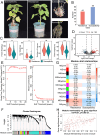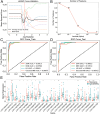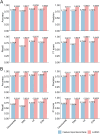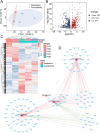Machine Learning-Based identification of resistance genes associated with sunflower broomrape
- PMID: 40380306
- PMCID: PMC12082884
- DOI: 10.1186/s13007-025-01383-8
Machine Learning-Based identification of resistance genes associated with sunflower broomrape
Abstract
Background: Sunflowers (Helianthus annuus L.), a vital oil crop, are facing a severe challenge from broomrape (Orobanche cumana), a parasitic plant that seriously jeopardizes the growth and development of sunflowers, limits global production and leads to substantial economic losses, which urges the development of resistant sunflower varieties.
Results: This study aims to identify resistance genes from a comprehensive transcriptomic profile of 103 sunflower varieties based on gene expression data and then constructs predictive models with the key resistant genes. The least absolute shrinkage and selection operator (LASSO) regression and random forest feature importance ranking method were used to identify resistance genes. These genes were considered as biomarkers in constructing machine learning models with Support Vector Machine (SVM), K-Nearest Neighbours (KNN), Logistic Regression (LR), and Gaussian Naive Bayes (GaussianNB). The SVM model constructed with the 24 key genes selected by the LASSO method demonstrated high classification accuracy (0.9514) and a robust AUC value (0.9865), effectively distinguishing between resistant and susceptible varieties based on gene expression data. Furthermore, we discovered a correlation between key genes and differential metabolites, particularly jasmonic acid (JA).
Conclusion: Our study highlights a novel perspective on screening sunflower varieties for broomrape resistance, which is anticipated to guide future biological research and breeding strategies.
Keywords: Feature selection; Machine learning; Resistance genes; Sunflower broomrape.
© 2025. The Author(s).
Conflict of interest statement
Declarations. Ethics approval and consent to participate: Not applicable. Competing interests: The authors declare no competing interests.
Figures






Similar articles
-
Biological and Transcriptomic Characterization of Pre-Haustorial Resistance to Sunflower Broomrape (Orobanche cumana W.) in Sunflowers (Helianthus annuus).Plants (Basel). 2021 Aug 30;10(9):1810. doi: 10.3390/plants10091810. Plants (Basel). 2021. PMID: 34579343 Free PMC article.
-
Wild Helianthus species: A reservoir of resistance genes for sustainable pyramidal resistance to broomrape in sunflower.Front Plant Sci. 2022 Oct 20;13:1038684. doi: 10.3389/fpls.2022.1038684. eCollection 2022. Front Plant Sci. 2022. PMID: 36340383 Free PMC article.
-
Development and characterization of a new sunflower source of resistance to race G of Orobanche cumana Wallr. derived from Helianthus anomalus.Theor Appl Genet. 2024 Feb 22;137(3):56. doi: 10.1007/s00122-024-04558-4. Theor Appl Genet. 2024. PMID: 38386181 Free PMC article.
-
Genetic and Genomic Tools in Sunflower Breeding for Broomrape Resistance.Genes (Basel). 2020 Jan 30;11(2):152. doi: 10.3390/genes11020152. Genes (Basel). 2020. PMID: 32019223 Free PMC article. Review.
-
Genome-wide identification and expression analysis of the Dof gene family reveals their involvement in hormone response and abiotic stresses in sunflower (Helianthus annuus L.).Gene. 2024 Jun 5;910:148336. doi: 10.1016/j.gene.2024.148336. Epub 2024 Mar 4. Gene. 2024. PMID: 38447680 Review.
References
-
- Mutuku JM, Cui S, Yoshida S, Shirasu K. Orobanchaceae parasite-host interactions. New Phytol. 2021;230:46–59. - PubMed
-
- Xu Y, Zhang J, Ma C, Lei Y, Shen G, Jin J, Eaton DAR, Wu J. Comparative genomics of orobanchaceous species with different parasitic lifestyles reveals the origin and Stepwise evolution of plant parasitism. Mol Plant. 2022;15:1384–99. - PubMed
-
- Chabaud M, Auriac M-C, Boniface M-C, Delgrange S, Folletti T, Jardinaud M-F, Legendre A, Pérez-Vich B, Pouvreau J-B, Velasco L et al. Wild Helianthus species: A reservoir of resistance genes for sustainable pyramidal resistance to Broomrape in sunflower. Front Plant Sci. 2022;13:1038684. - PMC - PubMed
-
- Saabna N, Keasar T. Parasitoids for biological control in dryland agroecosystems. Curr Opin Insect Sci. 2024;64:101226. - PubMed
Grants and funding
LinkOut - more resources
Full Text Sources

